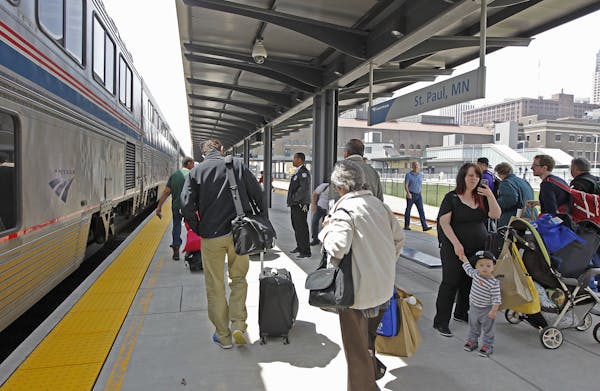After suffering one of the nation's worst downturns, Amtrak's passenger rail service through Minnesota is enjoying one of the nation's strongest bounce-backs.
Advocates of a second daily train to Chicago note that the turnaround is happening against the headwind of rock-bottom gas prices, reinforcing their case that there's a demand out there for rail service.
They're also taking a satisfied sidelong glance at long-haul competitor Megabus, which they say is beginning to wilt in parts of the Midwest precisely because it's gotten cheaper to drive. Megabus spokesman Sean Hughes doesn't deny that.
"Gas prices are a big deal," he said. "They're getting people back into cars and not taking a look at mass transit. With the competition of gas prices as well as some extraordinarily low airline prices, it's a tough competition out there."
The annual AAA holiday travel forecast reckons that American drivers have saved more than $27 billion at the gas pumps so far this year, compared to 2015.
The drivers' association expects 94 million people will take to the road for the holidays this year, more than last year, while travel in the category that includes trains and buses will dip slightly to 3.5 million people.
It is against that bleak backdrop that train fans are greeting the good news from Amtrak.
This time last year the passenger rail provider was ruefully acknowledging both a dip in overall national ridership and a 3 percent drop in ridership — down to 438,000 passengers — on the Empire Builder, which goes from Chicago through the Twin Cities and on to the Pacific coast. That was the seventh biggest drop among the 15 long-distance lines on the national network.
The biggest factor, Amtrak said: Delays caused by oil-boom trains on the same tracks.
Now Amtrak's fiscal year 2016 results are in, ending in September. The Empire Builder this time saw a 3.7 percent increase, to just shy of 455,000 passengers. The percentage jump was fourth-highest among the long-distance lines, nine of which recorded declines.
Twin Cities rail advocates say Amtrak is artificially constrained in Minnesota by running just one train a day through the state, which limits departure options and forces overnight stays in some cases.
"Our studies show it would exponentially increase riders to have a second train," said Ramsey County Commissioner Janice Rettman, who is chairwoman of the Minnesota High Speed Rail Commission. "The ability to, say, go to Red Wing and back on the same day, would make rail a lot more flexible."
Tim Mayasich, director of the Ramsey County Regional Railroad Authority, said Ramsey County has picked up much of the cost of initial studies but now looks to get help from the Legislature to help make the second train a reality. The Minnesota Department of Transportation's rail office is assembling a request, he said.
Amtrak spokesman Marc Magliari credits this year's bounceback by the Empire Builder to more reliable service and the refurbished Union Depot in downtown St. Paul.
"It's a little better than Midway, eh?" he said, referring to the sad-sack station that passengers used until 2014, when Amtrak moved downtown.
"On-time performance is improving," he said, "and we're in a more vital facility with more around it than being in an industrial area. We even have a Hertz [car rental] counter next to ours as well as restaurants, bike rental, coffee shops — things are happenin' there and it's helped."
Alternatives to driving
At the same time, Magliari said, it feels like Megabus is backsliding a bit in the Midwest, dropping services to some locations out of Chicago and trimming staff there.
Hughes confirmed Megabus is "restructuring Midwest operations due to service demands," with a pair of Michigan stops being dropped as well as the Chicago to Omaha route.
That followed a significant event for the once rapidly expanding service in 2015, when Megabus dropped service to Columbia and Kansas City, Mo. It was the first time in five years it had withdrawn from a top 50 U.S. market, according to researchers from the Chaddick Institute at DePaul University in Chicago.
Twin Cities service won't be affected when further changes take place next month, Hughes said. He added that Megabus offers strong advantages despite longer travel times.
"Our people tell me we are $20 to $40 cheaper than Amtrak depending on the trip, as well as our times of travel being more convenient," he said. "Amtrak has one train from Chicago to Minneapolis every day while we run four in the winter: morning, noon, evening and overnight."
Both competitors stress the value of a stress-free alternative to driving.
One reason the Empire Builder hasn't been hit harder by gas prices, Magliari said, is that people figure out driving and parking are annoying.
"The cost of parking in Chicago didn't go down," he said. "The 18-wheelers beside you on the freeway didn't go away. Other costs of driving aren't cheap. All that works to our advantage."
Hughes makes a similar pitch.
"Hop on the bus, play on your phone," he said. "You're not worrying about the stress of driving. Obviously a lot of it for us is college students, who love Megabus — they have free Wi-Fi and can bang out a term paper on the way home. They love it."
David Peterson • 651-925-5039
Carolyn Parnell, 'trailblazer' who served as Minnesota's first IT commissioner, dies

